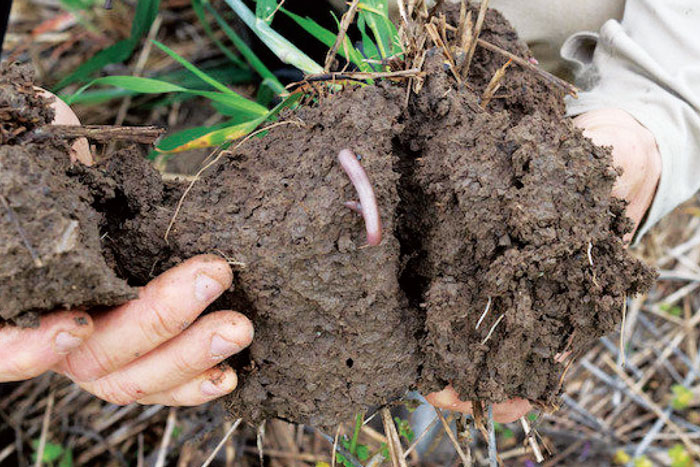(Editor’s Note: This is the first article in a series of educational stories that will appear in No-Till Farmer throughout 2025 that are designed to help farmers implement successful no-till practices. In this piece, Ray Archuleta explains why the “end game” of no-till is healthy soil and serves as the foundation for every management decision.)
For early no-tillers or those looking to start the practice, optimizing soil health and function is the ultimate endgame, says former NRCS soil scientist and nationally renowned soil health expert and agricultural consultant Ray Archuleta. That all begins by stopping the tillage.
“Healthy soil doesn’t want to be disturbed, and it wants to be covered perpetually,” he says. “And remember: The soil and plant are one — they are not separate.”
Archuleta estimates that some 80% of U.S. crop production soils are still “falling apart” as farmers transition away from conventional tillage as soil health doesn’t receive proper focus.
The primary reason for this degradation, Archuleta says, is a humus deficit. Organic matter is essential to creating the biotic glues that hold soil particles together, as well as holding nutrients in the soil.
These cementing agents are the result of metabolic processes of earthworms, arthropods, bacteria and fungi and include glomalin, which is produced on spores of arbuscular mycorrhizal fungi, polysaccharides and other carbon-based substances.
Because lost organic matter reduces aggregate stability, soil degradation increases as organic matter decreases.
The take-home message for no-tillers, Archuleta says, is that this all-important binding of soil particles must be constantly renewed by biological processes and can be destroyed by management choices that don’t regard soil as an ecosystem that depends on a host of interconnected factors.
Soil Livestock Key
Low soil disturbance and high diversity mimics nature and promotes healthy cycles within a soil ecosystem. A healthy microbial community, for example, is essential to a successful water cycle.
“Microbes are connected to the water cycle,” Archuleta says. “Organisms create the glues. If you don’t have the glues to hold soil structure, water doesn’t enter the soil. Soils are subaquatic systems. Bacteria are aquatic, protozoa are aquatic, nematodes are aquatic and earthworms like moist conditions.
“The reality is that everything is connected. If the water doesn’t get into the soil, the water cycle is not complete.”
Good soil structure also maintains the flow of oxygen and water to plants and microbes so they can maintain their ability to mineralize nutrients.
“If you don’t have the glues to hold soil structure, water doesn’t enter the soil…”
The biotic glues created by organic matter keep pores intact. More pores mean more porosity, and more porosity means more infiltration, Archuleta says, adding that if water is running off the field, the water cycle is not complete.
“The first thing no-tillers realize when they stop tilling is that the water cycle starts functioning,” he says. “People say, ‘I don’t have those wet spots anymore.’ You’re letting the glue-makers make their glue, you’re not bothering the habitat and, if you’re a really awesome farmer, nutrient cycling starts working.
“The water cycle, the bio community cycle, the water cycle, the nutrient cycle — they’re diminished on most farms and that’s why we have to haul in fertilizer. The soil isn’t functioning because it’s diminished. The biology is diminished. You mess with one cycle, you diminish the rest of them.”
Protecting Soil Life
Mycorrhizal fungi are another important component of the soil ecology, Archuleta says, and the management practices employed by farmers can have a dramatic effect on their health and relative abundance.
Tillage is especially detrimental because it diminishes the hyphae — the branching filamentous structure of the fungus — as well as reducing the spores necessary for propagation.
One of the reasons Archuleta favors perpetual cover is that fallow periods also reduce spore populations, as does poor soil drainage.

UNDER SOIL. Soil health expert Ray Archuleta says the presence of thousands of earthworms is a good indicator of soil health, and growers want to find them in abundance once no-till practices take hold. Photo by: No-Till Farmer Staff
Other practices detrimental to the mycorrhizae are stubble burning, which kills spores on the soil surface, and the use of those fungicides that are toxic to the fungi, he says.
Although a holistic approach to soil health and crop production can reduce the need for herbicides and pesticides, those agricultural chemicals appear to have little effect on the mycorrhizae when applied at recommended rates.
Archuleta notes that research results have been uneven and inconclusive regarding the use of mycorrhizal inoculants, but he is not opposed to them.
However, he points out that certain cover crops and corn are particularly good at promoting mycorrhizal spores in the soil.
Look Out Below
Archuleta says the presence of earthworms is a good indicator of soil health, and he wants to find them in abundance.
Likening earthworms to factory workers that help build the carbon-based glues that maintain soil structure, he points out that those workers cannot exist and thrive under harsh conditions. In extremely high temperatures in unprotected soils, for example, earthworms die and bacteria begin cannibalizing each other to survive.
“Healthy soil doesn’t want to be disturbed, and it wants to be covered perpetually…”
Castings produced by worms contain microbes, digested soil, chemicals similar to plant growth hormones and other ingredients designed to boost plant health. Illinois crop consultant Bill Becker analyzed the nutrients that one ton of worms typically add to an acre of no-tilled soil each year. His results showed that the worms produced 4 pounds of N, 30 pounds of phosphorus, 72 pounds of potash, 90 pounds of magnesium and 500 pounds of calcium, making worms a valuable addition to any nutrient management program.
“Go out there, smell your soil and count your earthworms,” Archuleta suggests. “You should have 1.5-3 million earthworms in an acre — anywhere from 40-150 earthworms in a square foot. If you don’t, that means some of the biology is missing.”
Earthworms can change the soil in just 48 hours, according to Archuleta. Living roots take a little longer — about 30 days — but also have a profound impact by “leaking” enzymes from root debris and border cells. The enzymes stimulate the nitrogen (N) cycle and are part of a communication process between roots and microbes.
What to Look For
A “checkup” can reveal a lot about a no-tiller’s most important resource – or help them discern what’s wrong with their soils that must be addressed.
Conducting an aggregate stability, or “slake,” test is a good way to assess soil health and compare fields with different histories, he says. Archuleta advises farmers to randomly select aggregates, or clods, from a field or fields and let them air dry, or microwave them until all the moisture is gone. When the aggregates are dry, drop them into a jar of water for each sample.
“What we want to see is an aggregate that does not fall apart,” says Archuleta, who now works for the non-profit Understanding Ag, which operates Soil Health Academy learning sessions across the U.S. “We want to see which one holds its integrity and withstands the force of pressure when the water rushes in to fill the pore spaces.”
Soil aggregates that fail the slake test are degraded and, typically, that’s what happens when conventionally tilled soils are tested.
A continuous no-till system, on the other hand, leads to more fungal-dominated soil that is better for decomposing organic material, Archuleta says. Not only do microbes break down crop residue and release nutrients, they build soil health by suppressing disease and improving soil structure.
Soil should be treated as an ecosystem habitat that farmers protect with no-till and feed with a varied food supply created by plant diversity.
No-Till Farmer's "Getting Started With No-Till Farming" is brought to you courtesy of Calmer Corn Heads.
Farmer Invented. Farmer Tested. Farmer Proven.® That motto explains Calmer Corn Heads’ company and state-of-the art corn head technology.
Calmer corn heads not only offers custom-built corn heads, we offer a custom experience. Whether its talking with our experienced sales team or directly with the folks who designed and built your corn head, we are committed to providing you top-notch service without the red tape of a big corporation.
We know Calmer Products work because we run them on our own farms. That’s why we offer a 100% Satisfaction of Your Money Back Guarantee!







